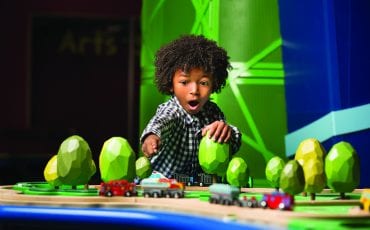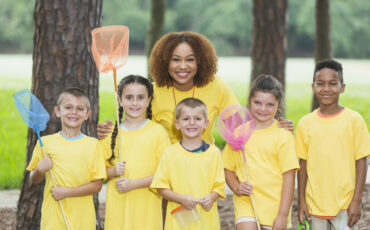Pink, Blue & Neutral: How Gender Stereotypes Shape Kids
How Gender Stereotypes Shape Kids
As soon as Marcy and Kyle Naismith discovered they were expecting boy and a girl twins, their world turned pink and blue. A stream of gender-specific clothes, toys and gifts started arriving. Through Marcy preferred more gender-neutral tones like red and orange, she couldn’t always fight the pastel-hued tide. After Tate and Lucy arrived, Marcy sometimes used color-coding to keep things like bottles straight. “We tried to steer clear of ‘boy’ and ‘girl’ things, but often, our options were pink and blue,” she recalls. Some gender symbols were all but impossible to avoid.
Society’s ideas about gender shape how even the tiniest babies are dressed, perceived and treated; in the groundbreaking Baby X experiment of 1975, adults who knew the baby’s gender handled girl infants more often and offered girls more gender-stereotyped toys, while boys were handled less. When adults did not know the gender, the babies were less likely to receive sex-stereotyped toys. Even parents like Marcy and Kyle who want to avoid gender-themed toys and clothes find that pink and blue have a way of creeping in, along with frilly princess frocks and ubiquitous sports motifs. So what’s the problem with the pink-blue paradigm? Does a baby tiara or the truck-themed bedroom set really matter when the child is still in diapers?

The Problem with Pink
Jo Paoletti, associate professor of American Studies at University of Maryland and author of Pink and Blue: Telling the Boys from the Girls in America (Indiana University Press, 2012), calls this phenomenon “pinkificiation.” And it matters, she says. Paoletti notes that “pinkificiation” goes beyond the use of pink for girl’s things – it also narrows choices and exclude gender-neutral options. Kids’ clothes and toys are becoming increasingly gendered, and researchers at National Association for the Education of Young Children report that gendered toys are less educational than gender-neutral playthings. “Pinkification” also teaches and reinforces stereotypes and limits the way children perceive themselves and others, she says. And, perhaps most troubling, it excludes children who don’t fit society’s gender mold.
Kids who fall outside the strict frills-or-football gender framework can feel left out, says Diane Ehrensaft, Ph.D., director of mental health at the Child and Adolescent Gender Center in Oakland, Calif. The second of her two grown children was “a very gender-nonconforming” boy, she says, with little interest in the trucks and other “boy” things she bought, while her daughter embraced dolls, pink, and all things girly. “I was committed to gender expansiveness for both my children, with a mixture of all types of toys for them to choose from,” says Ehrensaft, co-author of Gender Born, Gender Made: Raising Healthy Gender-Nonconforming Children (Workman Publishing Company, 2011). “They took it from there.”
Let Children Choose
As babies grow into toddlers, they begin choosing their own clothes and toys, often along gender lines. A study by the British Psychological Society found that by age 9 months, babies already prefer gender-specific toys and colors, with girls gravitating toward dolls and stuffed animals and boys choosing balls and cars. Similar results have been seen in studies with monkeys, suggesting that preferences for so-called stereotypical playthings might be innate. So there’s nothing wrong with letting a little girl wear frills and ruffles if she wants to, Ehrensaft says. The problem with pink “princess culture” isn’t necessarily that it limits girls, she says, but that it excludes boys.
The fact is, most children love shiny, sparkly things, she says. Who wouldn’t? Girls should have access to sparkles and frills if they want them, but boys should, too.
Parents sometimes cut boys off from this type of self-expression out of misguided fear that their child will “turn out” gay, she says. Nonsense, Ehrensaft says. “Gender is gender and sex is sex. Think of them as railroad tracks. They’re completely different tracks. Don’t make them be the same track. You’ll be confused and lose focus of your child.” There’s no way to tell whether a toddler boy who skips Army figures in favor of baby dolls will be gay, Ehrensaft says. “What you have is a gender-creative little boy. It’s not a sexual identity.” Trying to suppress a child’s early gender expressions is a losing battle, and doing so can cause lasting psychological harm, she says.

Insist on Plenty of Choices
The anecdote to limiting gender stereotypes is parent power, Paoletti says. “Parents can insist on more choices for their kids.” For babies and toddlers, more choices mean a more expansive view of themselves and others. The key is offering a spectrum of options, then standing back and respecting the choices kids make, and understanding that you can only engineer your baby’s social world so much, says Virginia Rutter, Ph.D. senior scholar with Council on Contemporary Families. “You can’t raise your child in a completely gender-neutral world. Some of those influences are going to come in.”
Marcy Naismith is OK with that. Despite having access to both “boy” and “girl” toys, her twins gravitate toward things associated with their own gender: Lucy loves hairstyles and her stuffed bunny, while Tate’s into trucks. “I want them to know that no matter what gender they are, they can do anything they put their minds to,” Marcy says.
– Malia Jacobson








